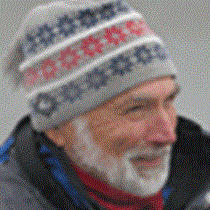Isla San Marcos & Santa Rosalia
It first looked like an orange line that grew into a perfect bell curve, then became cubic and finally transformed into the orange orb of sunrise. Low clouds added a beautifully smudged dimension to the horizon. The sea was flat calm as hundreds of widely dispersed least storm-petrels zigzagged just above the surface. Six dolphins passed in a tight formation with an apparent agenda, most likely concerning fish. Red and red-necked phalaropes flushed off the water as birders studied plumage patterns. One phalarope had a red belly, a harbinger of spring. We cruised and searched and visited on this glorious morning in the Sea of Cortez.
Our first stop was Isla San Marcos, an island built of chunks of volcanic rocks that look like they were mixed in pot of multicolored rock bubbling in a reddish stew. Gypsum has been mined from the surface of the south end of the island since the seventeen hundreds. Our time was spent on the north end where the water is a clear and beautiful green, and the rocky cliffs separate small beaches. It was a perfect place for snorkeling, kayaking and poking around. Kayakers set out in the calm water to explore the craggy black rocks and peer onto the beaches, while photographers and hikers made their way up a small canyon. Videographers concentrated on telling the story of the shore landing with helpful hints from the pros. Snorkelers dove into a beautiful grotto that had an underwater passageway to another hollowed-out cave. The underwater shoreline was exciting to explore because of its complex contours and variety of marine life. Most of the guests were able to see a stone scorpion fish, a most bizarre and poisonous species. They look so much like rocks that some guests have not recognized them as a fish even when pointed out from two feet away!
Santa Rosalia is a commercial center, a place to gas up on Highway 1, and a town to be immersed in copper-mining history, or at least that‘s what the guidebooks say. The people in the small cafes, bakeries, clothing stores, and all of those other service providers have a different story to tell. It’s the people praying in the church, the bubbly inn keeper at the Hotel Frances, the teenager bouncing around on the chair to music in the clothing store that’s a little too loud, the two guys in the little café that would have had to have been born here to look as they did and, except for us, there was not a gringo in sight. The museum offered a somewhat empty view of the mining history, but did have a collection of great old-time photos including one of a laborer posing, hands on an ore cart, dressed in a loin cloth and as gaunt and muscular as a cheetah. He looked like he could push that cart for the rest of his life. The beer and margaritas went down easily, and soon we were back at the ship hearing about the plans for tomorrow.




